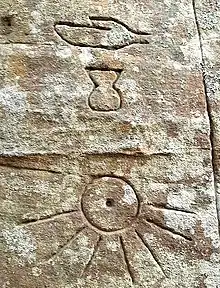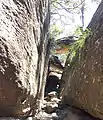Gosford Glyphs
The Gosford Glyphs, also known as Kariong Hieroglyphs, are a group of approximately 300 pseudo-Egyptian hieroglyphs located in Kariong, New South Wales, Australia. They are found in an area known for its Aboriginal petroglyphs, just between Gosford and Woy Woy, within the Brisbane Water National Park. The glyphs have been since dismissed as a hoax by authorities and academics after their discovery in the 1970s, but there are still attempts to prove the belief that they were carved by the ancient Egyptians about 4,500 years ago.[1]
 Egyptian-style petroglyphs | |
| Location | Kariong, Central Coast |
|---|---|
| Coordinates | 33°27′07″S 151°18′11″E |
| History | |
| Cultures | Egyptian culture |
Nonetheless, the site is the largest collection of Egyptian hieroglyphs outside of Egypt and Sudan.[2] While rumours of Egyptian glyphs have existed since the 1920s, they were first officially recognised by the National Parks and Wildlife Service in 1983.[3]
Description
The glyphs are carved into two parallel sandstone walls about 15 m (49 ft) long and 3 m (10 ft) high. The glyphs range between 5 cm (2 in) to 60 cm (24 in) in length and 1 cm (0 in) to 2.5 cm (1 in) in depth. They are primitive prototype of Old Egyptian and Middle Egyptian glyphs and tell their meaning by their illustration alone. The inscriptions on the east wall are carved deeper than those on the west, which are more eroded due to the predominant oceanic winds. The glyphs on both walls of the cleft feature around 26 paragraphs and the walls have a dark red colour, possibly caused by the usage of red ochre (iron oxide).[2]
They depict boats, chickens, dogs, owls, stick men, a dog's bone as well as two cartouches that appear to be the names of kings, one of them Khufu (second king of the Fourth Dynasty, 2637-2614 BC), the other uncertain. These names are given the same personal name and throne name. There is also a carving of the ancient Egyptian god Anubis.[4] According to Queensland Egyptologist Ray Johnson, who claimed to have done a transcription of the Kariong hieroglyphics, the carvings mark the burial site of Lord Nefer-ti-ru, a member of the Egyptian royal family, who had died there from a snake bite while leading an journey with his brother, Nefer-Djeseb.[2]
Discovery
The carvings were first formally reported in 1975 by Alan Dash, a local surveyor who had been visiting the area for seven years. Dash continued to visit for five years and reported that the number of hieroglyphs had increased every time that he visited.[4] Up until their discovery, the site of the glyphs was engulfed with sand and rocks, and had overgrown vegetation. In 1983, David Lamber, then a rock art conservator for the National Parks and Wildlife Service, found some clean-cut hieroglyphs which he estimated to be less than twelve months old.[4] From the mid 1990s, the site started to receive more public attention.
Since then, the hieroglyphs have been claimed by amateur Egyptologists to be authentic script created by ancient Egyptians about 4,500 years ago, who sailed to Australia and engraved their story into the stones after becoming shipwrecked.[5]
Authenticity

Scholar and Professor Ockinga has said "there are many reasons why they are not accepted as genuine hieroglyphics..."First of all the way they're cut is not the way ancient Egyptian rock inscriptions are produced, they're very disorganised..."There's also a problem with the actual shapes of the signs that are used. There's no way people would've been inscribing texts from the time of Cheops from the signs that weren't invented until 2500 years later." He suggested that the glyphs might have been made in the 1920s by Australian soldiers when there was general interest in ancient Egypt after the uncovering of the Tomb of Tutankhamun at that time. The soldiers, who had served in the Sultanate of Egypt from the mid 1910s to early 1920s, cited an example of shapes in the form of the Sphinx and a pyramid known to have been made by a returning soldier.[1]
Australian Professor of Egyptology Naguib Kanawati has also stated that they are not authentic and that they "were constructed in the early 1980s",[3] concluding that the hieroglyphs within the same panels were of widely different periods and some were carved backwards.[6] Other theories for their creation include high school students who copied them from their textbooks in 1970s and a Yugoslavian immigrant with an interest in Egyptology who etched them in the early 1980s.[3] Geologists have stated that the sandstone in which the hieroglyphs are carved erodes quickly and nearby 250-year-old Aborigine petroglyphs (Bulgandry Aboriginal Art Site) show considerably more erosion.[6]
Conversely, Dr Hans-Dieter von Senff, who graduated from the University of Newcastle with a PhD, claims that ‘‘Australia was discovered in the Third Dynasty [about 5000 years ago]. The Egyptians landed at Cape York Peninsula and moved south’’. Indigenous historian Steven Strong also believes in the glyphs' authenticity, saying, "They [the Egyptians] came here 5000 years ago as part of a sacred sabbatical. They wanted to exchange knowledge with the Aborigines, but they learnt a lot more than they brought." According to Strong, the interaction continued until the 17th century when the Egyptian travellers were caught stealing sacred stones from the desert, and thus "The Aborigines tracked them all the way to Balmoral Beach in Sydney and killed them".[3]
Recognition
Although they are widely debunked, the National Library of Australia in Canberra and the British Museum in London contain many files and books that have reports of the glyphs. Furthermore, they have been examined by the biblical archaeologist Alan Roberts, and recognised by the general director of the Cairo Museum Dr. Dia Abou-Ghazi, and as well as the former Egyptian minister of antiquities, Dr. Zahi Hawass.[2]
Gallery
 The parallel walls upon which the glyphes are carved
The parallel walls upon which the glyphes are carved Miscellaneous symbols, including a sphinx and the Eye of Horus
Miscellaneous symbols, including a sphinx and the Eye of Horus Egyptian God Anubis, the largest carving on the site
Egyptian God Anubis, the largest carving on the site
References
- "Egyptologist debunks new claims about 'Gosford glyphs'". ABC News. 14 December 2012. Retrieved 7 December 2014.
- Burial Site of Lord Nefer-Ti-Ru, Son of King Khufu, c.2637-2614 BC, Fourth Dynasty of Egypt (Gosford, NSW, Australia) Dr. R.M. de Jonge, October 2014
- Kelly, Matthew (20 October 2012). "Ancient Egyptians lived near Woy Woy: fact or fantasy?". Newcastle Herald. Retrieved 7 December 2014.
- Coltheart, David (Oct–Nov 2003). "Debunking The Gosford Glyphs". Archaeological Diggins. 10 (5).
- The stories and legends behind the hieroglyphs in Kariong by Star 104.5, 21 January 2019. Retrieved 29 September 2020.
- Kenneth L. Feder, Encyclopedia of Dubious Archaeology: From Atlantis To The Walam Olum, page 120-121(Greenwood, 2010). ISBN 978-0-313-37919-2